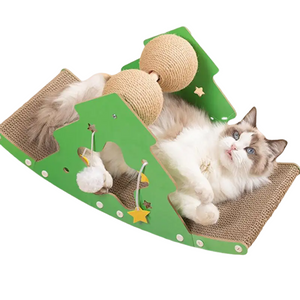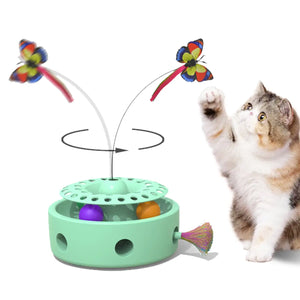Introduction
As cat owners, we aspire for our cats not only to be healthy and happy but also to adapt to human daily life and interact harmoniously with other pets and people at home. Socialization training plays a critical role in achieving this goal, particularly for kittens, whose early experiences profoundly influence their personality and behavior in adulthood.
This article delves into the fundamental principles of cat socialization and offers detailed training techniques. Additionally, it includes recommendations for products that can facilitate this process.

1. The Core Objectives of Socialization Training
The primary goal of socialization training is to help cats learn how to engage appropriately with humans, other pets, and their environment. Well-socialized cats typically exhibit the following characteristics:
-
Emotional Stability: They are less likely to be startled by everyday noises, strangers, or new environments (Bradshaw, 2018).
-
Predictable Behavior: They exhibit fewer aggressive or excessively fearful behaviors (Crowell-Davis et al., 2004).
-
Adaptability: They can adjust to new environments, household changes, and interactions with other pets.
Cats that do not undergo proper socialization are often more sensitive to external stimuli, which can result in stress-related behaviors, such as avoiding humans, displaying persistent aggression, or urinating in inappropriate places (Overall, 2013). Thus, it is crucial to begin socialization training as early as possible.
2. When is the Optimal Time for Cat Socialization Training?
The most critical period for socialization is between 2 and 7 weeks of age (Karsh & Turner, 1988). During this phase, a kitten’s brain is rapidly developing, enabling them to quickly learn and respond to external stimuli. This period is crucial for kittens to learn how to interact with other cats, pets, and humans.
Although adult cats can still undergo socialization training, the results are often less pronounced compared to kittens. Adult cats tend to be more cautious about new experiences, requiring more time to adjust. However, with patience, it is still possible to help them gradually build trust (Casey & Bradshaw, 2008).

3. Detailed Steps for Cat Socialization Training
3.1 Gradual Adaptation to New Environments
Cats are highly sensitive to changes in their environment. Whether you are bringing a cat home or moving houses, it is important to adopt a phased approach. Initially, allow the cat to explore a single room, gradually familiarizing itself with its food, toys, and resting area. Once the cat is comfortable with this limited space, you can expand its range to other parts of the home (Overall, 2013).
Steps:
- Place the cat’s bed, food, and water in a quiet and secure corner.
- Spend 15 to 30 minutes daily interacting with the cat in this area, allowing it to feel safe in your presence.
- Once the cat begins to move freely within this space, consider expanding its activity range.
Recommended Product:
-
Scratching boards and cat trees, which provide a territorial space for cats in a new environment, helping them release tension through scratching.
3.2 Training for Human Interaction
Although cats are naturally independent, with proper techniques, they can form strong emotional bonds with humans. You can strengthen your connection with the cat through gradual contact, play, and feeding (Crowell-Davis et al., 2004).
Steps:
- Begin by sitting quietly near the cat without rushing to pet it, allowing it to approach you.
- When the cat starts showing interest in you, speak to it in a gentle voice, and extend your hand slowly, allowing the cat to sniff.
- Use treats or toys as rewards. When the cat initiates contact, provide positive reinforcement.
Recommended Product:
- Interactive cat toys, which stimulate the cat’s curiosity and help foster positive interactions during play.
3.3 Introducing Other Pets
If there are other pets in the household, such as dogs or other cats, their first meeting must be handled with great care. Initially, keep the animals in separate spaces, allowing them to observe each other through a door or barrier without direct contact (McCune, 1995).
Steps:
- Ensure that each pet has its own safe space where it will not be disturbed.
- Facilitate a scent exchange by using the same towel or toy to help the pets become familiar with each other’s smell.
- Once the animals seem calm in their separated spaces, you can allow them to see each other without making physical contact.
Recommended Product:
3.4 Training for Interaction with Strangers
Cats are often wary of strangers. To help them become accustomed to new people, a gradual approach is recommended. Invite friends over to visit but refrain from having them immediately interact with the cat. Allow the cat to decide when it feels comfortable approaching new individuals (Casey & Bradshaw, 2008).
Steps:
- Ask your guests to sit quietly within the cat’s sight but avoid making direct contact initially.
- If the cat appears curious or approaches, encourage your guests to offer treats or toys to engage the cat.
- If the cat shows signs of stress, do not force interaction. Instead, provide a safe hiding place such as a cat tree or house where the cat can retreat.
Recommended Product:
- Cat house and calming products, which provide a secure space for the cat to retreat to when strangers are present, helping them feel at ease.
3.5 Acclimatization to Sounds and Environmental Changes
Cats are highly sensitive to everyday noises and changes in their environment, such as vacuum cleaners, washing machines, and doorbells. To help your cat adapt, you can start by exposing them to these sounds at low volumes and gradually increase the intensity (Karsh & Turner, 1988).
Steps:
- During the cat’s active time, play recordings of household sounds at a low volume, allowing the cat to adjust to the noise.
- When the cat remains relaxed, reward it with treats, helping it associate these sounds with positive experiences.
Recommended Product:
- Calming products for cats, such as those that release pheromones to help cats remain calm in response to everyday environmental stimuli.
4. Long-Term Benefits of Socialization Training
Socialization training not only aids in helping cats adjust to family life but also significantly reduces behavioral problems, particularly when other pets or children are involved (Overall, 2013). Well-socialized cats are better equipped to handle changes in the household, such as moving, new pets, or new family members.

References
- Bradshaw, J. W. S. (2018). The behavior of the domestic cat. 2nd ed. CABI Publishing.
- Casey, R. A., & Bradshaw, J. W. S. (2008). The effects of additional socialization for kittens in a rescue center on their behavior and suitability as a pet. Applied Animal Behaviour Science, 114(1-2), 196-205.
- Crowell-Davis, S. L., Curtis, T. M., & Knowles, R. J. (2004). Social organization in the cat: A modern understanding. Journal of Feline Medicine and Surgery, 6(1), 19-28.
- Karsh, E. B., & Turner, D. C. (1988). The human-cat relationship. In Turner, D.C. & Bateson, P. (Eds.), The domestic cat: The biology of its behaviour (pp. 159-177). Cambridge University Press.
- McCune, S. (1995). The impact of paternity and early socialization on the development of cats' behavior to people and novel environments. Applied Animal Behaviour Science, 45(1-2), 109-124.
- Overall, K. L. (2013). Manual of clinical behavioral medicine for dogs and cats. Elsevier.





















